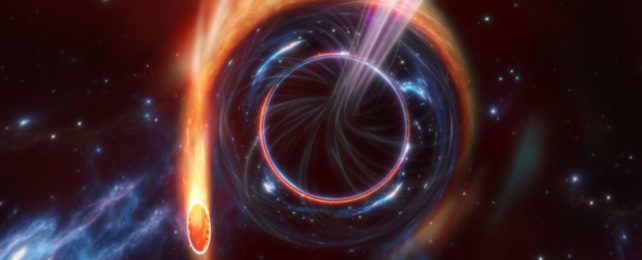Light that traveled for more than 8.5 billion years to reach us was the last gasp of a dying star as a black hole swallowed it.
Two separate teams of scientists determined that a mysterious glimmer that appeared in the sky in February 2022, named AT2022cmc, was the astrophysical jet that erupted from the massive black hole as the shredded star vanished beyond its event horizon.
It's incredibly rare for us to catch one of these meals in the act, and AT2022cmc is now the most distant we've ever seen.
The two papers have been published in Nature and Nature Astronomy.
"The last time scientists discovered one of these jets was well over a decade ago," says astronomer Michael Coughlin of the University of Minnesota Twin Cities in the US.
"From the data we have, we can estimate that relativistic jets are launched in only 1 percent of these destructive events, making AT2022cmc an extremely rare occurrence. In fact, the luminous flash from the event is among the brightest ever observed."
There's a lot going on in our wild Universe, and a lot of encounters and events – supernovae, fast radio bursts, stellar collisions, interactions in compact binaries, and black hole feeding frenzies – are unpredictable, spitting out temporary flares of light that blaze across the vastness of space, and then fade away.
Only by closely monitoring large swathes of the sky can we catch the light of these colossal but transient cosmic events.
In February, the Zwicky Transient Facility caught just such a flare. Immediately, 20 other telescopes around the world and in space sprang into action, capturing a bucketload of data on the sudden blaze over the days and weeks that followed.
From this wealth of information, a team of researchers – co-led by Coughlin and astronomer Igor Andreoni of the University of Maryland – determined that the event resulted from a tidal disruption event. The perpetrator? A rapidly spinning supermassive black hole up to around 500 million times the mass of the Sun, gulping down star material at a tremendous rate of half a Sun a year.

Tidal disruption events are extreme; they occur when a star wanders just a little too close to a black hole. The tidal forces in that black hole's gravitational field stretch the star, pulling it so hard that it's torn apart. The star debris then falls onto the black hole.
This process produces a flare of light that fades over time, but we can detect it from Earth if it's bright enough.
That's not what produced the light astronomers saw from AT2022cmc.
"Things looked pretty normal the first three days. Then we looked at it with an X-ray telescope, and what we found was, the source was too bright," says astronomer Dheeraj Pasham of MIT, who led the second paper.
"This particular event was 100 times more powerful than the most powerful gamma-ray burst afterglow. It was something extraordinary."
Analysis revealed that the cause of the light was an astrophysical jet. When a black hole feeds, sometimes not all material swirling around it ends up beyond the event horizon.
Magnetic field lines just around the outside of the event horizon act as particle accelerators; some material close to the black hole gets funneled along these lines, where it is launched from the black hole's poles at speeds close to that of light.
In the case of AT2022cmc, one of those jets is pointed straight at us and traveling at 99.99 percent of the speed of light. When material moves towards us at close to the speed of light, it appears brighter than it is because the motion produces a change in the frequency of the wavelength of the light. This effect is known as relativistic beaming, or Doppler boosting because that change is known as the Doppler effect.
AT2022cmc is only the fourth Doppler-boosted tidal disruption event ever detected.
Scientists expect that we can learn a lot from this dying light from over half a Universe away. For example, it's unknown why some tidal disruption events have jets and some don't. The rapid spin of the black hole may be instrumental in the formation of jets.
It's also unclear how supermassive black holes form and grow. High feeding rates, such as exhibited by the AT2022cmc black hole, might help resolve the mystery.
The event was also the first jetted tidal disruption event detected using an optical survey. The scads of data collected will help astronomers identify more of them in the future.
"Astronomy is changing rapidly," Andreoni says.
"More optical and infrared all-sky surveys are now active or will soon come online. Scientists can use AT2022cmc as a model for what to look for and find more disruptive events from distant black holes.
"This means that more than ever, big data mining is an important tool to advance our knowledge of the Universe."
The research has been published in Nature and Nature Astronomy.
